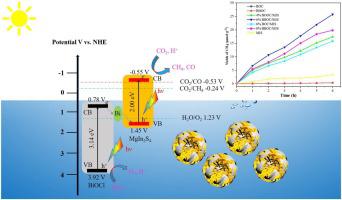Journal of CO2 Utilization ( IF 7.7 ) Pub Date : 2021-01-24 , DOI: 10.1016/j.jcou.2021.101453 Zhong-wei Zhang , Rui-tang Guo , Jun-ying Tang , Yu-fang Miao , Jing-wen Gu , Wei-guo Pan

|
Step-scheme (S-scheme) Bi-BiOCl/MgIn2S4 heterostructure (BBOC/MIS) was successfully fabricated via NaBH4 reduction and facile in-situ hydrothermal process and applied in photocatalytic CO2 reduction. A part of BBOC ultrathin nanosheets processed by ultrasonication exfoliation was grown on the surfaces of MIS marigold microflower. Another part of BBOC and MIS exhibited as the core and shell of BBOC/MIS, respectively. The morphology, band alignment, optical and electronic characteristics of photocatalysts were comprehensively studied via diverse characterization methods. The S-scheme BBOC/MIS heterojunction possessed superior photocatalytic performance and well reusability to primarily convert CO2 into CH4 with high efficiency under the simulated solar light irradiation without using any sacrificial agent in water. Experimental results displayed that the 6% BBOC/MIS sample behaved the optimal photocatalytic performance in photocatalytic reduction of CO2, and its maximum CH4 production rate could reach up to 4.29 μmol g−1 h−1, which was about 7.56 times as high as that of unadulterated MIS. The enhanced photocatalytic performance of BBOC/MIS could be attributed to the improved visible light response and highly-efficient separation of the photogenerated electron-hole pairs between BBOC and MIS through the S-scheme heterojunction interface. In addition, the metal Bi acted as the bridge connecting the BOC and MIS to facilitate the charge transfer, which greatly promoted the CO2 photocatalytic reduction to CH4.
中文翻译:

具有逐步机制的二氧化碳光还原成甲烷的Bi-BiOCl / MgIn 2 S 4异质结构的制备
通过NaBH 4还原和简便的原位水热工艺成功制备了阶梯式Bi-BiOCl / MgIn 2 S 4异质结构(BBOC / MIS),并将其应用于光催化CO 2还原。在MIS万寿菊微花的表面上生长了通过超声剥落处理的BBOC超薄纳米片的一部分。BBOC和MIS的另一部分分别作为BBOC / MIS的核心和外壳展示。通过多种表征方法对光催化剂的形貌,能带排列,光学和电子特性进行了综合研究。S型BBOC / MIS异质结具有出色的光催化性能和良好的可重用性,可以将CO 2最初转化为CH4,在模拟太阳光照射下高效,无需在水中使用任何牺牲剂。实验结果表明,6%的BBOC / MIS样品在CO 2的光催化还原中表现出最佳的光催化性能,其最大CH 4产生率可达4.29μmolg -1 h -1。大约是纯净MIS的7.56倍。BBOC / MIS的增强的光催化性能可以归因于改善的可见光响应以及通过S型异质结界面在BBOC和MIS之间高效分离了光生电子-空穴对。此外,金属Bi充当连接BOC和MIS的桥,促进电荷转移,极大地促进了CO 2光催化还原为CH 4。



























 京公网安备 11010802027423号
京公网安备 11010802027423号